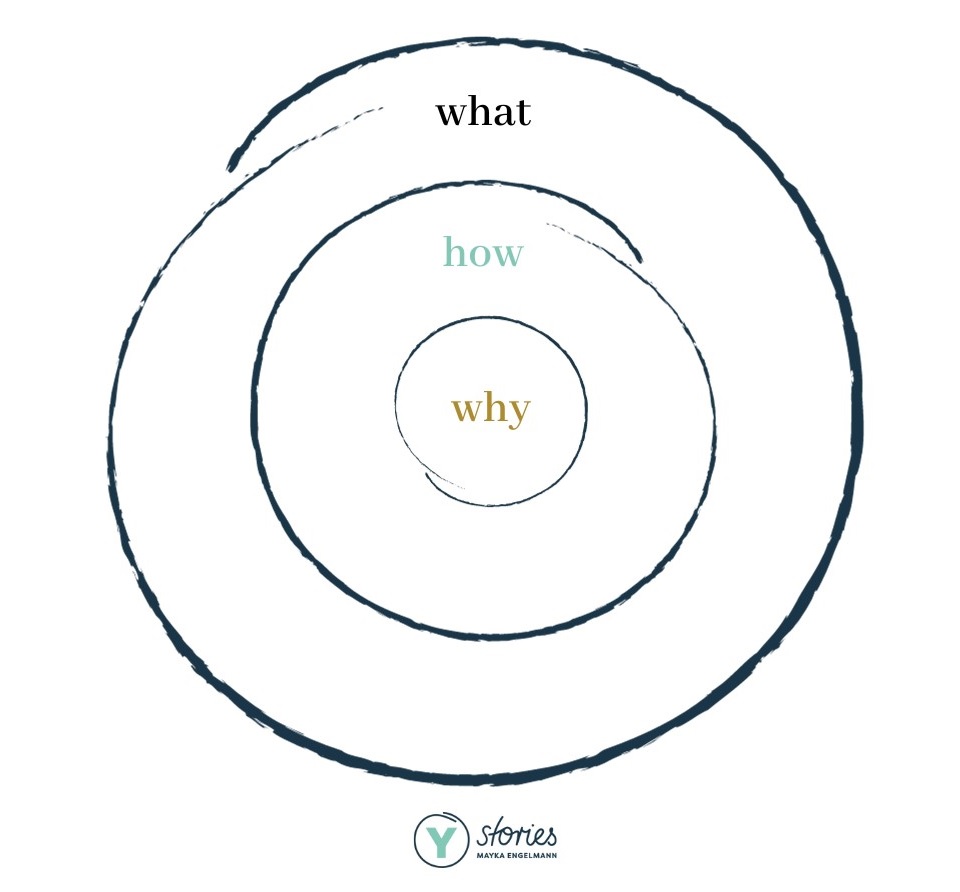Brand Purpose: The golden thread of successful companies
Brand Purpose: Is it important or can it go?
The other day I was looking for a pair of sports shoes for my son. I was shown a total of eight shoes from four different shoe brands. Without hesitation, I went for the brand I have been emotionally attached to for almost 20 years: the brand with the three stripes.
The first steps into the hallowed halls of the “World of Sports”, spontaneous tennis matches, early morning runs and extended lunch dates at the “Stripes” with colleagues from all over the world are forever etched in my mind and heart.
Do you know which company I’m talking about? But what makes this brand different from the others?
Successful companies do things differently, that much is certain. But they also think differently than their less successful competitors.
But how do they do it? In a time marked by the climate crisis and other crises, constant change and a relentless oversupply of information and products, one concept has proven to be the golden thread in corporate management over the past decades – brand purpose.
What this is exactly and what it has to do with emotions, values and golden threads is what I would like to shed light on in this article.
I will show you how brands create socio-cultural value with attitude and why it will also pay off for you in the long run to take a close look at your own brand purpose.
What is all this for?
I’m probably not telling you anything new when I state here once again: Our prosperity is hanging by a thread. Economic growth is reaching its limits. Climate crisis, lack of raw materials, pressure to innovate, digitalisation – to name just a few powerful buzzwords.
Consumers are becoming more mature and have greater expectations of the promises and messages that brands carry to the outside world. More and more employees, especially younger ones, are looking not only at working conditions and the number on the pay slip, but also at what their company stands for.1
The question of what for automatically raises the question of meaning. The question of the “higher” purpose of business and the entire value chain.
Companies need new ideas, must become more creative and explore new dimensions of value creation, away from thinking in terms of growth and profit maximisation, in order to remain in the market in the long term. In this new dimension of value creation, social and cultural added value, authenticity, sustainability, a healthy and happy workforce and social progress are gaining in importance.
In this new economy of meaning, brand purpose is gaining importance.
Hype or heartfelt topic? What brand purpose means
The concept of brand purpose is becoming increasingly important when it comes to successfully managing a brand. But what exactly does the term mean? And what doesn’t it mean?
The English term Purpose refers to “meaning”, “ambition” or “intention”. Companies with a purpose stand for sustainable thinking and action. Purpose is basically what makes it worthwhile to get up in the morning and go to work. And this does not mean the salary slip. It means the deeper values of a company with which employees can identify and connect.
Brand purpose refers to a brand’s raison d’être. This is based on the social, cultural and/or ecological value of a brand for society as a whole.
It therefore refers to the overarching vision behind a brand or a company. It is sometimes used synonymously with the term corporate purpose and has much to do with corporate identity or brand identity.
A clear brand identity that is consistent and authentic should make it clear to customers, employees and investors: who you are and what you stand for, that you are pursuing meaningful long-term goals and that you create value that goes far beyond monetary profit.
The brand identity manifests values and norms that are a kind of beacon for people. Thus, in the concept of brand purpose, the social, cultural and ecological value and meaning of a brand moves to the centre and thus to the heart of the brand and is not merely an additional benefit or an “add-on” to the brand. This leads me to the question of what brand purpose is not.
Brand purpose is not a hype that will soon disappear. The term reflects a trend that has been in the offing for many years: a change in values that affects all areas of life. Maybe it’s just a buzzword, but in my opinion they also have their raison d’être. Because they, too, merely reflect a social development and thus bring the important topic of “brand purpose” into the public discourse.
What brand purpose is also not is an invention of marketing and not just a slogan created by an expensive advertising agency.
An authentic brand purpose is not something that can be imposed from the outside. Otherwise, the core remains hollow and collapses like a house of cards at the slightest shake.
In search of the golden thread
The brand purpose must come from the depths of the company and thus from the people and the stories. Only when the brand core is strong enough can it shine through to the outside, to the surface, and make a difference in the world.
Global brands such as Adidas, Nike, Google and Apple have one thing in common: they can all clearly state why they exist, what they stand for and what makes them tick. (It’s no coincidence that I still talk about my time at the three stripes).
But how do we find this golden thread? Let’s start with the what question:
“Start with Why” is a motto of Simon Sinek, who is a successful storyteller and coined this phrase, like no other, through his book of the same name.2
Simon Sinek and the concept of the Golden Circle first became known in 2009 through the TED Talk “How Great Leaders Inspire Action”.3 In this talk, Sinek very graphically described the success path of inspiring leaders, such as Steve Jobs with Apple, for whom the “why” is at the centre of communication.
He visualised his communication model in three circles of different sizes, which are located inside each other. The inner circle is formed by the why and corresponds to the brand purpose. To understand the secret of the concept, we have to take a look at all the circles.
The Golden Circle
What does your company do? Software? Medical technology? So far so good.
Most companies can say what they do. But very few clearly articulate why they do it. Mostly because they put profit before sense. Or simply because they have not yet paid enough attention to the question.
According to Sinek, most companies focus on the what and thus communicate from the outside (what) to the inside (why). They go from the most tangible item – which can be a product or service – to the least tangible item.
Some companies can also be clear about how they do it. The how is what makes them special and sets them apart from other competitors. It is also called a unique selling proposition in marketing parlance.
But few companies know why they do what they do. The why, however, is never monetarily driven, as profit or turnover in Sinek’s concept is only the result of a strong Whys. Within this inner circle is the purpose and the emotionally charged vision. And thus what successful brands do differently. They communicate authentically, emotionally and consistently. From the inside to the outside.
And this can also be explained neurobiologically. The human brain, seen in cross-section from top to bottom, is divided into three important parts that correspond perfectly to the Golden Circle (source: Simon Sinek). When we communicate from the inside out, we can directly address the limbic system, the part of the brain where emotions such as trust and a good gut feeling arise.
If a message arouses emotions, for example by linking to experiences and values, it enters the long-term memory. The limbic system is particularly addressed by stories, images and emotionally charged words such as “death” or “love”.4
“Why-Brands” inspire other people to share their belief in a meaningful value or a big idea through emotionally charged messages that come from the heart.
A short statement is usually not enough to comprehensively describe a brand’s purpose. “In most cases, accompanying explanations are needed that place the purpose statement in a cultural and strategic context and explain it concretely for different areas of application and fields of action.”5
Examples of successful brand purpose
Let’s take another close look at companies that are ahead of the game when it comes to brand purpose.
A prime example is the popular outdoor brand Patagonia. Their purpose statement “We’re in business to save our planet.” is not an empty marketing promise, but a thoroughly lived attitude.6 Patagonia is not listed on the stock exchange and all profits go to climate protection and other non-profit organisations.
But many German companies have also positioned themselves as successful purpose brands for many years. The company Sonnentor uses the profits they generate from the sale of organic teas, herbs and spices to support “people, nature, the environment and society”. Their statement: “We at SONNENTOR firmly believe that nature contains the best recipes for a beautiful and long life. That is what we work for. That is what we live by.“7
One particular example is, in the truest sense of the word, the purpose brand Einhorn. Founded at the beginning of 2015, the Berlin-based start-up Einhorn sells condoms that are produced fairly and sustainably. 50 per cent of the revenues are to be reinvested in social and sustainable projects. Because for the founders Philip Sievers and Waldemar Zeiler, business is part of the solution. Since 2019, Einhorn has therefore been a responsibly owned company. Their statement. “With Einhorn, we want to prove that a company can be profitable and add value for people and the environment.”8
As Einhorn’s communication impressively shows, not only authenticity and consistency, but also originality is an important differentiator in the implementation of the brand purpose. Who else would come up with the idea of improving the world with condoms?!
Brand purpose do’s & don’ts: How to find your golden thread
Finally, I would like to share a few things that can help you in your search for your brand purpose:
- Start With Why: Start with the “why question”.
- Be sure to include the inner circle of your company, i.e. the employees, in your search.
- If you see no hope, get an external consultant on board.
- Don’t make promises you can’t keep.
If a brand makes false promises or does not follow up its promises with action, it will be exposed and cause lasting damage to the brand. Because customers who buy products because of a higher purpose are particularly sensitive.
Conclusion: The circle is closing
In a time full of challenges and a growing need for meaning, brand purpose is the golden thread to long-term success for companies. It is not just a marketing tool, but a deeply rooted inner compass. The heart of every company.
Companies with a clear purpose do not only act for profit, but pursue a higher meaning. They communicate from the inside out, creating emotional connections and staying in people’s minds.
Brand Purpose is not just a trend, but a survival strategy. The purpose serves as a beacon for employees, suppliers and customers and creates added value for society.
A company’s brand is no longer artificially charged by its Purpose, but shows what real possibilities exist for people and what potential a company wants to exploit together with its employees.
It enables people to actively contribute to a better world and make a meaningful statement. To feel self-efficacious. To broaden their horizons. Every company should therefore think hard about its own purpose in order to be successful in the long term and inspire others to do the same.
That way, together we can make the world a little better.
That sounds purposeful, doesn’t it?
Notes (partly in German):
If you want to learn more about brand purpose or maybe even tell your story authentically, it’s worth visiting Mayka Engelmann’s great website.
[1] Warum sich mehr Mitarbeitende einen nachhaltigen Arbeitgeber leisten können
[2] Book by Simon Sinek: Start with Why
[3] Ted Talk by Simon Sinek
[4] Storytelling: Geschichten als Wohltat für das Gehirn
[5] Baezgen Andreas: Brand Purpose (2002). Schaeffer-Poeschel Verlag für Wirtschaft · Steuern · Recht GmbH
[6] Padagonia: Core Values
{7] Sonnentor: Wir sind halt anders
[8] Einhorn: About us
This is a best of blog post 2023.
If you like the article or want to discuss it, feel free to share it with your network.

Mayka Engelmann
Mayka Engelmann has a degree in cultural and media studies, is a Northern light, has two children and loves stories and the sea. With Y stories, she helps companies develop messages with depth that show attitude and don’t reproduce bullshit. She gives co-creative brand strategy workshops, but also likes to get on the train to broaden horizons.

